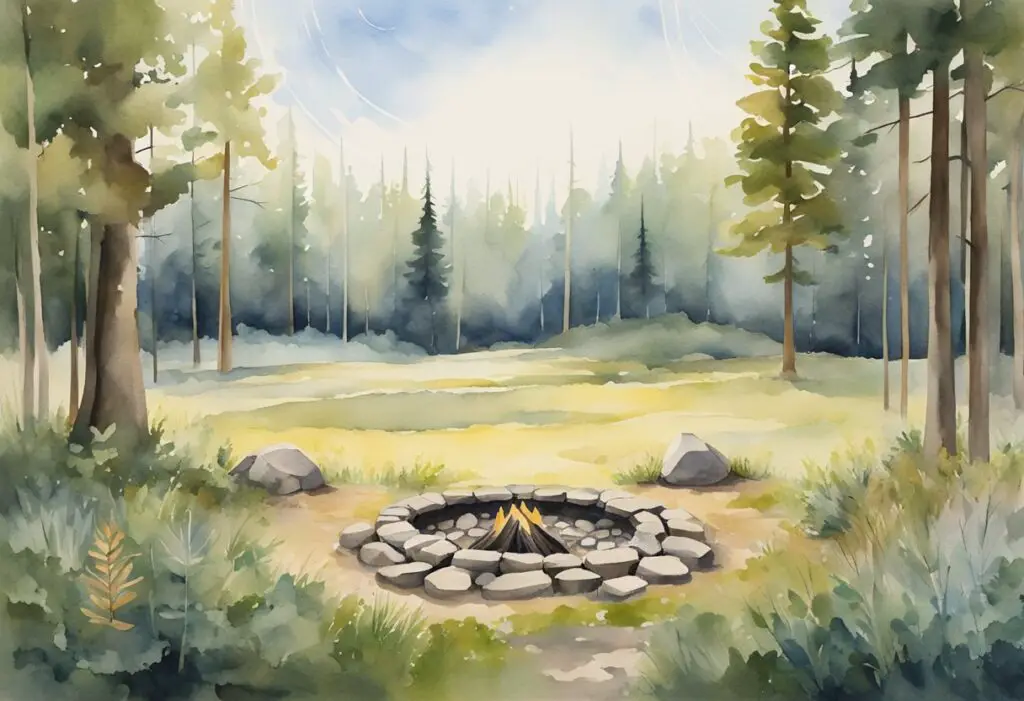Embark with curiosity on a journey into the heart of Native American spiritual healing. This rich tapestry of traditions, deeply woven into the cultures of Indigenous peoples, offers a unique perspective on wellness and harmony. As you explore these practices, you’ll find that they are not just medical treatments but a holistic approach to life itself.

Native American spiritual healing connects physical health with spiritual well-being through the use of ceremonies, herbal remedies, and sacred objects. From the soothing rituals of the sweat lodge to the symbolic power of sage and cedar, each aspect of these practices aims to restore balance and connect you with the natural world. The wisdom that has been passed down through generations offers insights into maintaining spiritual and physical health in a way that resonates with modern wellness seekers.
The role of the healer, often called a shaman or medicine person, is central to these traditions. They guide their communities with a deep respect for the sacredness of life and the interconnectedness of all things. Whether you’re seeking to understand the use of traditional herbs or the significance of spiritual ceremonies, the world of Native American healing invites you to look beyond the surface and discover its profound depths.
-

Celestial Soul Eco-Friendly Tote Bag
$18.50 Select options This product has multiple variants. The options may be chosen on the product page -

Celestial Soul Women’s T-Shirt
Price range: $20.00 through $21.50 Select options This product has multiple variants. The options may be chosen on the product page
Understanding Native American Spiritual Healing
Native American spiritual healing involves a blend of traditional practices and beliefs focused on achieving harmony and balance within oneself and the environment. These practices are rooted in centuries-old traditions and reflect a profound connection to nature and spiritual elements.
Historical Context and Origins
The origins of Native American spiritual healing are deeply intertwined with the history and culture of indigenous tribes. Each tribe has its own unique practices that have been passed down through generations. Traditional healing encompasses methods that go beyond physical ailments, focusing on maintaining balance and harmony in life. The use of the medicine wheel symbolizes this balance, representing the interconnectedness of the four elements: earth, air, fire, and water. You can explore more about how each element represents various aspects of life, including spiritual and emotional wellness.
Spirituality is a central aspect of healing, where rituals such as ceremonies and songs play a significant role. Each tribe might have different methods, but the core belief remains the same—healing is achieved through restoring harmony with the natural and spiritual world.
Philosophies and Core Beliefs
Native American healing philosophies focus on a holistic approach, where the mind, body, spirit, and emotions are all interconnected. You are encouraged to embrace an understanding of health that includes spiritual wellness alongside physical well-being. This approach recognizes the power of nature and spiritual elements in achieving complete health.
The idea of balance and harmony extends to interpersonal relationships and the environment, believing that disruptions in these areas can affect an individual’s health. Practices often involve the community, as a reminder that healing involves relationships with others. Interconnectedness is crucial, emphasizing that personal health is linked to the wellness of the community and nature itself.
Traditional practices incorporate elements such as ceremonial tobacco, which is used not for physical healing but for spiritual purposes. Understanding these philosophies may offer you insight into a profound system of healing that has supported Native communities for centuries.
Key Elements of Healing Practices

In Native American spiritual healing, various elements work together to restore balance to mind, body, and spirit. Understanding the role of healers, the influence of nature, and the use of herbs provides insight into these practices.
Role of the Healers
In Native American communities, healers such as medicine men and shamans play a vital role. As a healer, you are considered a bridge between the physical and spiritual realms. Your responsibilities often include leading ceremonies and rituals that seek harmony and balance. This might involve prayer, chanting, and the use of sacred objects. You’re often deeply respected within the community, where your guidance can provide both physical and spiritual healing.
Becoming a healer typically involves rigorous training and initiation. You might be chosen due to specific spiritual gifts or family heritage. The role involves continuous learning and a deep understanding of spiritual practices. Healers serve as cultural historians, passing down traditions to ensure the community’s cultural heritage remains alive.
Significance of Nature and the Universe
Nature plays an integral role in Native American healing practices. As you engage with the natural world, you recognize the interconnectedness of every living being. The universe is not just a backdrop for ceremonies; it is an integral part of healing. The spiritual themes often emphasize harmony and balance, crucial to the healing process.
The cycles of nature, such as the seasons and lunar phases, can influence the timing of ceremonies. Certain landscapes, like mountains or rivers, are considered sacred spaces where spiritual energy is more potent. You might use these spaces for rituals to enhance spiritual healing, relying on their inherent power to cleanse and renew the spirit.
Use of Herbal Remedies and Medicinal Plants
Herbal medicine is a cornerstone in traditional Native American healing practices. As a practitioner, you may use a variety of plants for their medicinal properties, addressing both physical and spiritual ailments. Plants like sage and cedar are commonly employed for purification and protection in ceremonies.
You’re likely to learn about these plants through traditional knowledge passed down through generations. This includes understanding which plants to use, how to harvest them sustainably, and the methods of preparation for maximum efficacy. The use of herbal remedies is not only for physical healing but also to connect spiritually, recognizing the life force within each plant. This holistic approach emphasizes the balance between the body, mind, spirit, and the natural world.
Sacred Ceremonies and Rituals
Native American sacred ceremonies are deeply embedded in spiritual practice and community healing. These rituals involve purification and spiritual renewal, helping participants connect with their culture, environment, and spiritual beliefs. Whether it’s through the intense heat of a sweat lodge or the grounding rituals of smudging, each ceremony holds unique significance.
Sweat Lodge and Smudging Ceremonies
Participating in a sweat lodge ceremony immerses you in a ritual of purification and spiritual growth. The lodge is a small, dome-shaped structure heated by hot stones. Inside, you experience intense heat and steam, which encourages you to release both physical and spiritual impurities.
In contrast, a smudging ceremony involves using the smoke from burning sacred plants like sage, cedar, or sweetgrass. This practice is believed to clear negative energy, providing a cleanse that prepares you for deeper spiritual engagement or other rituals.
Vision Quests and Pipe Ceremonies
Engaging in a vision quest is a deeply personal spiritual journey. Typically undertaken by indigenous youth, this involves spending time in nature while fasting and praying for guidance and insight. The quest is seen as a rite of passage, helping you find your spiritual path and personal vision.
In a pipe ceremony, the sacred pipe becomes a conduit for prayers, connecting your spirit with the divine. Smoking the pipe allows for a communal expression of prayer, encouraging unity and shared spiritual exploration.
Drumming, Chants, and Storytelling
Drumming, along with chants and storytelling, serves as both spiritual expression and community bonding. The rhythmic beats of drums are considered a communication with spiritual entities. They create a sacred space for meditation and connection.
Chants amplify the spiritual atmosphere, allowing you to immerse yourself in the flow of the ritual. Storytelling imparts wisdom, cultural values, and spiritual lessons across generations, preserving the richness of tradition and keeping it alive through shared experiences and teachings.
Cultural Significance and Modern Practice
Understanding Native American spiritual healing involves respecting indigenous traditions, recognizing the impact of cultural appropriation, and considering the inclusion of non-natives. These aspects are crucial for preserving the integrity of traditional healing practices while adapting them to contemporary contexts.
Respecting Indigenous Traditions
When engaging with Native American spiritual healing, you should prioritize the respect for indigenous cultures. This means acknowledging the deep-rooted history and spiritual significance of practices like ceremonies, rituals, and the use of sacred herbs.
Traditional healing practices are not just medical procedures; they are deeply intertwined with community and spiritual life. For example, herbs like tobacco are used not only for medicinal purposes but also for spiritual healing. Respect for these practices involves an appreciation for the spiritual lore and oral traditions that have kept these methods alive for centuries.
The Impact of Cultural Appropriation
Cultural appropriation poses a significant threat to the authenticity of Native American spiritual healing. When non-natives adopt these practices without proper understanding or respect, it diminishes their spiritual importance. This can lead to the misrepresentation of indigenous cultures, reducing sacred rituals to mere trends.
For example, using sacred symbols or rituals without consent from the community can strip them of their sacred meaning. It’s crucial to approach these practices with cultural humility and seek permission or guidance from native practitioners.
Inclusion of Non-Natives in Healing Practices
Today’s modern practices often involve the participation of non-natives. While embracing this inclusion, it’s important to approach with balance and sensitivity. Some tribes and communities encourage non-natives to participate, emphasizing the need for openness and mutual respect.
Incorporating American Indian and Alaska Native values into broader mental health practices can be beneficial, fostering a sense of communal healing. You may encounter opportunities to participate in public ceremonies or workshops that help bridge cultural gaps, promoting healing and understanding across diverse communities. Make sure you do so with a sincere interest in honoring the traditions and wisdom of native healers.
Holistic Wellness and Personal Development

Embracing Native American spiritual healing can enhance your health by integrating physical, emotional, and spiritual aspects. This holistic approach promotes balance, mental peace, and personal growth, fostering deeper self-awareness and cultural connection.
Mental and Emotional Healing
The practices here often involve rituals that nurture your mind and emotions, helping to release negativity and restore peace. Techniques like smudging and meditation ground you in the present moment, easing stress and promoting clarity.
For emotional healing, ceremonies may incorporate elements like music or storytelling, which encourage expression and reflection. These activities provide a safe space to explore your feelings and process emotions, guiding you toward greater mental health.
Balancing the Physical and Spiritual
Harmonizing your physical and spiritual wellness is essential in these traditions. Physical activities, like traditional dances, not only keep your body fit but also strengthen your connection to spiritual roots. These dances are often part of larger ceremonies that emphasize the unity of body and spirit.
Herbal remedies, such as those mentioned in Native American practices, offer natural ways to support physical health while respecting spiritual beliefs. The integration of these remedies into your routine fosters well-being and a deeper personal connection to the environment.
Overcoming Substance Abuse through Spiritual Connection
For those facing challenges with substance abuse, spiritual practices serve as a powerful healing tool. Connecting with a higher power through prayer or specific rituals can instill hope and resilience. Such practices provide guidance and support, reinforcing your commitment to personal growth and sobriety.
Community gatherings or healing circles invoke spiritual strength and unity, offering a supportive network that encourages accountability and healing. Through these connections, you can find encouragement and wisdom to navigate recovery, promoting lasting change and well-being.

